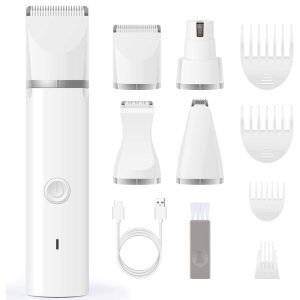How to Care for a Newly Acquired Puppy

The newly adopted puppy is unfamiliar with its owner and the home environment, frequently exhibiting timid behavior. Due to their lack of social experience, they may appear clueless and timid in their actions. Additionally, their physical resistance is relatively weak, making them more susceptible to illness. Owners need to invest more effort in their care and acquire the necessary pet care knowledge.
I. Thoroughly Clean and Disinfect the Environment
Before bringing the puppy home, it is recommended to use two different brands of professional disinfectant to thoroughly sanitize the home environment in two separate applications. After the puppy moves in, continue regular disinfection while maintaining good indoor air circulation and a dry environment to create a healthy living space for the puppy.
II. Avoid Bathing Your Puppy Immediately
Some owners rush to bathe puppies upon arrival, concerned about uncleanliness or exposure to unsanitary pet store environments. This practice carries significant risks. After leaving their original environment and companions, puppies are prone to endocrine imbalances, which can weaken their immunity. Even if vaccinated, catching a cold during this period may trigger more severe illnesses.
It is recommended to avoid bathing for the first 15 days after bringing your puppy home. If dirt appears on the coat, gently comb it out or use dry shampoo powder for cleaning.
III. Minimize Disturbances
With their immune systems already weakened by the environmental change, puppies require rest. However, many first-time owners, driven by excitement and curiosity, frequently pick them up or take photos—actions detrimental to their health. Allow the puppy ample rest and ensure sufficient sleep. If possible, place them in a crate to provide a relatively quiet resting environment.
IV. Limit Outdoor Activities
Puppies have weak immune systems and should not be taken outdoors indiscriminately. Avoid high-risk areas like veterinary clinics and pet markets where viruses may be concentrated. Minimize outings until all vaccinations are completed to reduce disease exposure.
V. Standardize Feeding Practices
While owners naturally provide attentive care, avoid overindulgence that leads to improper feeding. Factors like environmental changes, dietary adjustments, or water adaptation can trigger health issues. Since their digestive systems are still developing, daily feeding should primarily consist of high-quality dog food, administered three times daily. Avoid adding other foods besides the prescribed kibble. Follow the principle of small, frequent meals—a slight sense of hunger is acceptable, but overfeeding must be avoided to prevent digestive strain.
Provide lukewarm water; never feed tap water directly. Simultaneously, organize household items, paying particular attention to hard-to-reach areas like under beds and sofas to prevent accidental ingestion of small objects. If feasible, add a moderate amount of goat milk powder to the kibble, ensuring the food is soaked in warm water until soft before serving. This feeding approach is not stingy but a scientifically sound choice prioritizing the puppy’s health.
VI. Monitor Core Health Indicators
Beyond implementing the above five care measures, closely observe body temperature and alertness—these are key indicators of a puppy’s health. As long as both remain normal, excessive worry is generally unnecessary.
VII. Delaying Puppy Vaccinations
Vaccines contain weakened viruses. Puppies have low immunity when first brought home, and vaccinating them at this stage often leads to serious health issues. Consult a professional veterinarian at the breeder’s facility to determine the optimal vaccination timing. Never decide the schedule independently.
admin
-
Sale!

Washable Pet Cooling Pad for Cats and Dogs
$10.99Original price was: $10.99.$9.99Current price is: $9.99. This product has multiple variants. The options may be chosen on the product page -
Sale!

Washable Cat Window Hammock Cooling Bed
$23.99Original price was: $23.99.$22.99Current price is: $22.99. -
Sale!

Tropical Amphibian Rainforest Tank, Lizard Cage
$38.99Original price was: $38.99.$36.99Current price is: $36.99. -
Sale!

Silent 4-in-1 Waterproof Charging Dog Hair Trimmer
$49.88Original price was: $49.88.$47.99Current price is: $47.99.